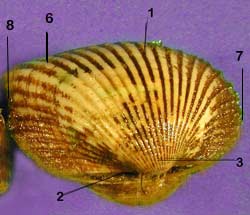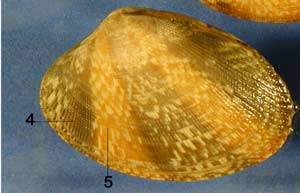![]() General Morphology
General Morphology
![]() Families: Arcidae, Mytilidae,
Pinnidae, Pectinidae,
Ostreidae, Solecurtidae,
Veneridae.
Families: Arcidae, Mytilidae,
Pinnidae, Pectinidae,
Ostreidae, Solecurtidae,
Veneridae.


Bivalves: shell in two pieces of equal or unequal size joined by a hinge.
1. Radial ribs
2. Ligament
3. Umbo
4. Radiating sculpture
5. Concentric sculpture
6. Left valve
7.Anterior end
8. Posterior end
Family Arcidae
Small to medium, thick, trapezoidal shells, with inflated posterior and flattened cardinal area. Some with byssal gape. Usually with strong radial ridges and fine concentric lines; often with brown zebra-like bands. External, elongate, striated ligament. Wide, inrolled or recurved beaks. Straight hinge with many small teeth in two continuous rows. Interior porcellaneous , with interior margin often strongly dentate. Lacks pallial sinus. Two adductor muscle scars, nearly equal in size. Thick, bristly, matted, brown periostracum. Attach to substrate by a silky byssus. Often burrow in mud and sand, under stones, or in dead corals. Mainly intertidal, but also shallow to deep water.
Family Mytilidae
Small to large, thin, elongate shells with rounded posterior. Equivalve. Smooth or with radial ribs and concentric growth lines. Ligament usually external. Sharp beaks at anterior. Long hinge line, sometimes with a few, very small, weak teeth behind sunken ligament. Inside nacreous. Anterior margin generally denticulate. Anterior muscle scar small, posterior muscle scar large. Periostracum usually thick brown or black, often hariy; some thin, glossy and very colorful blue or green. Found on rocks, pilings, under stones, in mud or sand, often in large colonies, in intertidal waters.
Family Pinnidae
Medium to very large, very thin, translucent, brittle, wedge-shaped shells, gaping at posterior. Smooth or with radial ribs, some scaly or spiny. Equivalve. Long, linear external ligament. Beaks near anterior. Toothless hinge. Thin nacreous layer on part of interior. Anterior muscle scar small, posterior muscle scar large and near centre. Silky byssus at umbo. Edible. Anchors vertically in mud, sand or gravel, in shallow to deep waters.
Family Pectinidae
Small to very large fan-shaped to nearly circular shells. Mostly inequivalve. Amusium has thin, disk-shaped, slightly convex; upper (left) valve reddish, lower (right) valve near-white; small radial ribs inside. Chlamys has both valves convex; unequal ears; prominent radial ribs, often with scales. Scallops have extremely large range of colors and patterns, often remarkably bright. One adductor muscle scar near center of valve. The muscle is important for its commercial value as scallops. Found mostly in shallow to very deep water.
Family Ostreidae
Small to very large, usually thick shells with irregular radial ribbing. Often with lamellar surface. Inequivalve. Internal ligament, located centrally in a triangular or elongated pit. Prominent beaks. Toothless, straight hinge. Single large adductor muscle scar near center of both valves. Oysters are of high commercial value.
Family Solecurtidae
Medium to large, thin, elongate-rectangular, cylindrical shells, with rounded, stongly gaping ends. Smooth; or with oblique or concentric striations. External ligament, posterior to beaks. Small beaks, usually near center. Weak, narrow hinge. Two cardinal teeth in right valve, one in left valve; no lateral teeth. Pallial sinus present. Thick, often wrinkled, periostracum. Found in sand and mud flats from shallow to deep waters.
Family Veneridae
Mostly medium-sized, thick, ovate or heart-shaped shells. A great variety of concentric and radial sculpture, most often with rounded, concentric ribs. Porcellaneous surface, often polished; many with attractive rays, zigzag blotches and other markings often crenulate. Prominent external ligament. Prominent beaks placed toward and pointed to anterior end. Usually with three cardinal teeth in each valve; may have weak lateral teeth. Pallial sinus present. Found slightly below surface in sand or mud from intertidal to deep waters. Many are edible. Largest bivalve family, with over 400 species.